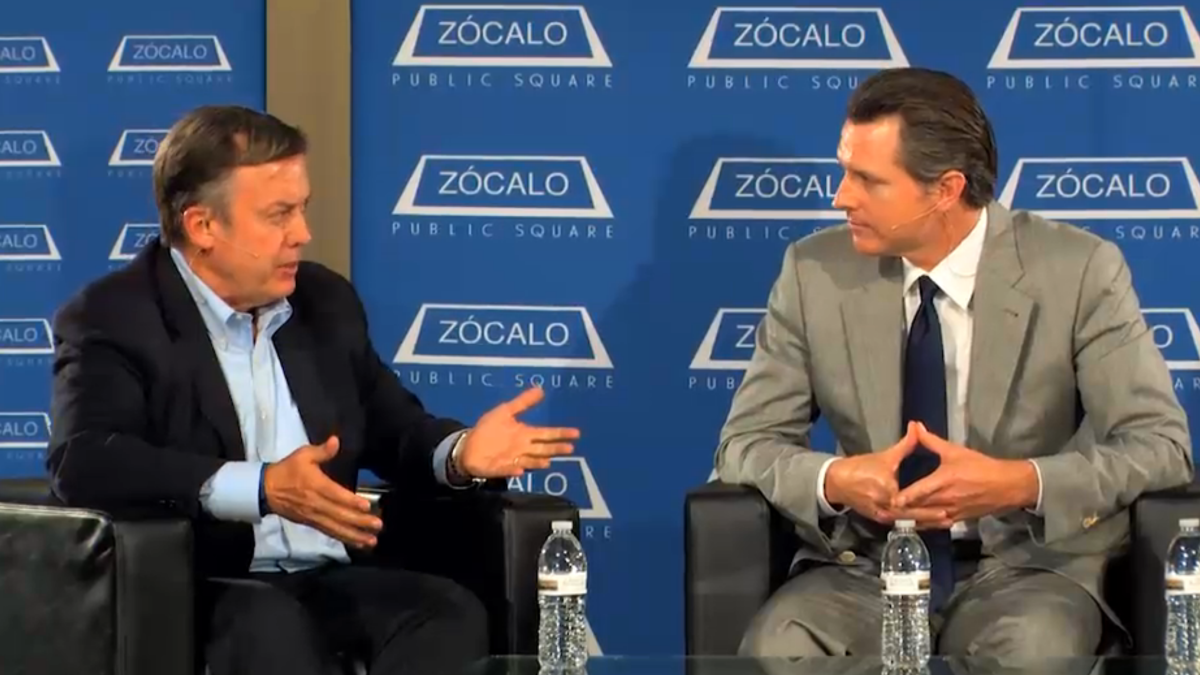Calif. leader: State can learn from model set by ASU

Arizona State University President Michael M. Crow (left) at a discussion with California Lt. Gov. Gavin Newsom in Sacramento. Newsom said ASU's work in providing access to education was "intriguing" and something his state should follow.
Photo by: Zocalo Public Square
California's public universities need to innovate and increase access for more students if the state is to remain economically strong, according to Gavin Newsom, the lieutenant governor of that state, who told a Sacramento audience this week that there are lessons to be learned from the model forged by Arizona State University and its president, Michael M. Crow.
“Michael has had that opportunity and has begun to move in I think a radically different direction,” Newsom said. “It’s very intriguing, his success, as a model, for the kinds of conversations we need to start having here in the state [of California].”
Newsom, the former mayor of San Francisco, joined Crow in a conversation in Sacramento sponsored by Zócalo Public Square on May 18.
The discussion touched on a range of issues, including the demand for increased access to post-secondary education and the future of online classes – all areas addressed in Crow’s book “Designing the New American University,” which was co-written with William Dabars.
Crow argued that one of the first things universities – especially public schools – should feel compelled to address is providing as much educational opportunity as possible.
“Rather than public universities working to emulate private universities by becoming more and more exclusive, how could [they] build teaching, learning and discovery institutions that have the capability of engaging the entire demographic of our society,” Crow said.
ASU, he said, is asking itself a central question to tackle that challenge – and coming up with the answer.
“How can we demonstrate in a new model to add to the existing models the ways in which an integrated accessibility, excellence and impact university could be designed, built and deployed to work?” Crow said.
Crow was asked by the moderator, Sacramento Bee publisher Cheryl Dell, to project the future of the recently announced Global Freshman Academy, a partnership between ASU and the online education company edX to provide college credit online at a relatively inexpensive cost.
Crow described the evolution he expected in massive open online courses, or MOOCs, which will form the basis of the academy. He indicated that critics of the plan are likely imagining present-day MOOCs, which often are just a video stream of a lecture. He compared that to an early 20th-century technology.
“We’re going to take MOOCs to the next level,” he said. “So they’re not going to be dial-up telephones; maybe they’ll be smartphones.”
Crow said that with future iterations of MOOCs, comparing what a student learns in a traditional classroom to what a student learns online will be simple.
“Do you understand chemistry or not? Do you understand biology or not? Do you understand physics or not?” Crow said. “And not only will you understand it, but you’ll understand it more deeply than you would have understood it through a normal process for most students.”
Newsom noted that that kind of thinking has its detractors.
“That scares a lot of folks,” he said, “because we’re so familiar with the old model.”
Zócalo describes itself as “a not-for-profit ideas exchange that blends live events and humanities journalism.” It is an affiliate of Arizona State University. Crow has participated in several Zócalo events.
Innovation in higher education seems to be a passion of both Crow and Newsom.
The lieutenant governor argued that for California to remain economically vibrant it would have to educate more of its citizens.
“Unless we do something big, unless we’re bold, on this access issue California’s clock is about to get cleaned,” he said.